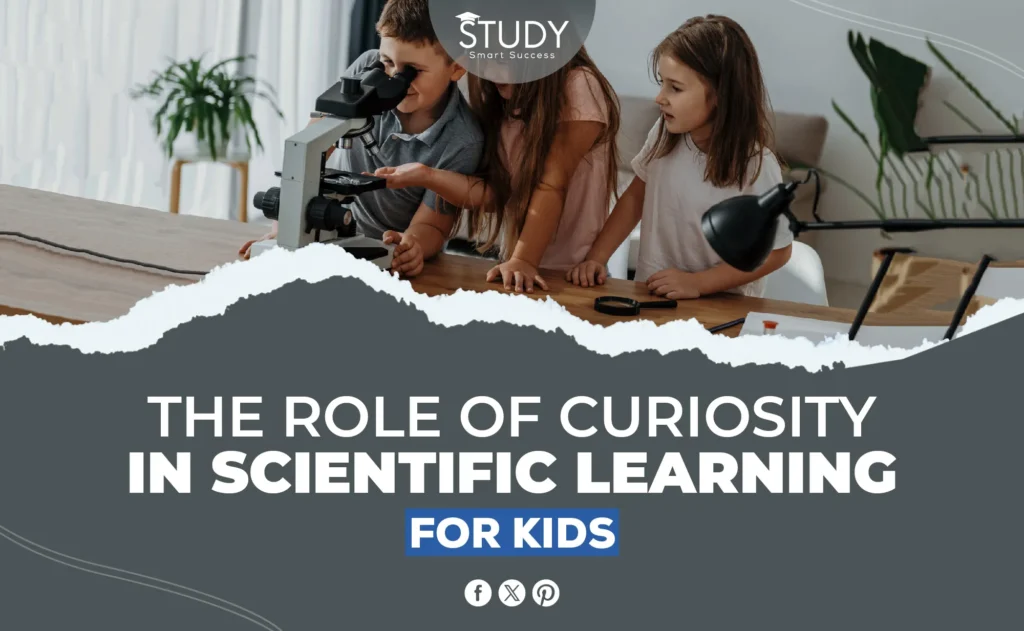Introduction
Every aspect of childhood growth is marked by curiosity, which drives knowledge. Curiosity in Learning for Kids is evident as children naturally seek new experiences and answers, exploring their environment and asking questions. The urge to learn more about the world is not merely a passing curiosity but essential to early cognitive development.
In science education, curiosity drives greater understanding and inquiry. It inspires kids to turn passive scientific observations into active experiments and explorations. This blog post discusses how curiosity supports scientific learning for youngsters and provides practical advice on fostering it.
Read more about Using Technology and Education to Maximise Student Potential.
What is Curiosity?
Being curious is an essential psychological trait everyone has, and it’s obvious when you’re a child. This section discusses why kids are naturally curious, the different kinds of curiosity, and how curiosity significantly affects brain growth.
Why Are Children Naturally Curious?
Children are naturally curious, which pushes them to try new things that help them learn, adapt, and stay alive. It gets kids to explore and connect with their surroundings, which allows them to learn how to solve problems as they try new things and learn from their mistakes. It also helps their minds grow by making them think about what they already know and understand.
Types of Curiosity
Each sort of curiosity affects a child’s learning and development. Sensory curiosity drives newborns and toddlers to physically interact with their surroundings through touch, smell, sight, taste, and hearing. As youngsters mature, cognitive curiosity includes understanding complicated ideas, solving puzzles, and asking how things operate. Social curiosity improves empathy and communication by exploring others’ thoughts and feelings.
The Role of Curiosity in Brain Development
Curiousness affects early brain development. Exploration and questioning boost neuronal growth in memory and learning areas in children. With each new encounter and information gained, new synapses form, promoting brain connectedness and intellect. Frequent curiosity activation develops sophisticated cognitive skills, equipping youngsters for complex thinking later in life.
Understanding these characteristics of curiosity illuminates its importance in scientific learning and intellectual development.
Curiosity as the Foundation of Scientific Learning
Curiosity enhances a child’s daily life and underpins scientific learning. This inherent tendency for exploration and questioning fits wonderfully with the scientific method, encouraging children to pursue scientific brilliance. This section discusses how curiosity supports the scientific method and how basic queries have led to significant experiments and discoveries.
Connection Between Curiosity and the Scientific Method
Curiosity starts with the scientific method. This essential feature prompts scientific questions, such as observing occurrences, formulating hypotheses, conducting experiments, assessing outcomes, and drawing conclusions. Children’s curiosity drives them to observe, ask questions, and experiment, which are essential to the scientific method. It drives all scientific investigation, making it necessary for discovery and innovation.
Examples of How Questions Lead to Experiments and Discovery
History has many examples of how simple curiosity led to significant scientific discoveries. Take a look at this:
- Isaac Newton and Gravity: The famous story of Newton and the falling apple shows how a moment of interest in how things fall can lead to a lifetime of learning. This interest led to many ideas and tests that led to the discovery of the law of universal gravitation.
- Marie Curie’s Radioactive Discoveries: Curie’s fascination with uranium rays kept her testing until she discovered radioactivity. She won the Nobel Prize in both physics and chemistry for this work.
- Alexander Fleming and Penicillin: Many people might have ignored seeing mold on a culture plate. However, Fleming’s interest in how it worked led to the finding of penicillin, which completely changed how medicine is done today.
These examples show the importance of curiosity in science research. They show that even the most straightforward questions can lead to answers that significantly change how we think about the natural world.
Encouraging Curiosity in Educational Settings
Because curiosity leads to ongoing learning, encouraging it should be a top priority in school and home settings. This section discusses how teachers and parents can promote wonder and gives examples of good ways to use inquiry-based learning in the classroom. It also discusses how important it is to create exciting environments that encourage exploring.
Role of Educators and Parents in Fostering Curiosity
Parents and teachers play a significant role in sparking a child’s interest. Instead of just giving answers, teachers should ask open-ended questions that make students think deeply and explore. This way of teaching gets students involved in the learning process and makes them value finding.
Parents can support this method by pushing their kids to ask questions at home, discussing interesting topics, and being excited about finding answers with their kids. Their work together builds a bridge of interest between school and home, giving them a strong base for learning and growing.
Classroom Strategies to Promote Inquiry-Based Learning
In inquiry-based learning, the student is an integral part of the process; they can ask questions, work through problems, and gain new insights. Project-based learning programs that require students to study, ask questions, and solve problems can help. This will encourage students to be naturally curious all the time.
Also, using Socratic questioning helps students understand things better and gets them more interested in learning. Field trips and practical projects are also great ways to connect what you learn in the classroom with real-life situations that make you even more curious and think critically.
Importance of a Stimulating Environment That Encourages Exploration
The learning environment’s design and atmosphere foster inquiry. Classrooms should be full of materials for students to explore and interact. Flexible learning environments that may be modified for varied research and activities increase student engagement. Creating a safe and open environment where students may share their ideas and explore without judgment encourages risk-taking and innovation in learning.
Curiosity can be fostered by intentionally augmenting instructors and parents, using dynamic classroom tactics, and carefully constructing learning settings. These practices have enduring effects on pupils’ education and beyond.
Barriers to Curiosity and How to Overcome Them
Many impediments in traditional education systems might inhibit curiosity, which is essential for learning, especially in science. Educators and parents must understand and plan to overcome these challenges. This section examines common educational obstacles to curiosity, practical ways to foster it, and the importance of failure in scientific discovery.
Common Obstacles in Traditional Education Systems
Routine study and standardized testing in traditional education might stifle curiosity. These methods may value memorization above creativity and discovery, limiting inquiry-based learning. Large classrooms and tight curricula can also limit individualized and curiosity-driven learning.
Tips for Parents and Teachers to Overcome These Barriers
To get around the limitations of standard school settings, parents and teachers can try the following:
- Encourage Questioning: Getting kids to ask questions at home and school is essential. Answer questions with interest and excitement; if you can, look into the answers together.
- Create Learning Opportunities: Parents and teachers can create places that are full of tools and encourage exploration. This could be done by giving the kids access to books, projects, or field trips that are interesting to them.
- Integrate Flexible Teaching Methods: Instead of only textbooks, teachers can use project-based learning, group discussions, and hands-on exercises that encourage students to explore and figure out solutions.
Technological Tools and Resources to Stimulate Curiosity
Modern education relies on technology to spark interest, especially in science. Digital tools, interactive platforms, and specialized kits allow students to actively and intuitively explore scientific subjects. This section discusses digital resources, interactive websites, and age-appropriate scientific instruments that boost curiosity-driven learning.
Digital Resources and Apps That Encourage Scientific Inquiry
Apps and digital resources help kids study science in new ways. The Google Scientific Journal app turns mobile devices into portable scientific labs, letting students use sensors to conduct experiments and collect data. The Elements app brings chemical elements to life with vivid pictures and interactive features.
Interactive Science Websites and Virtual Labs for Kids
Interactive science websites and virtual labs for kids offer safe and fun scientific experimentation online. Mystery Science’s story-based teachings engage kids and inspire science enthusiasm. PhET Interactive Simulations from the University of Colorado Boulder provides free math and science simulations that let students modify variables and watch real-time consequences to grasp complicated scientific concepts better.
Recommendations for Age-Appropriate Scientific Tools and Kits
Choosing the correct scientific instruments and kits can help kids understand and enjoy science. Interactive kits like the Osmo Genius Kit combine physical and digital elements for 5-8-year-olds to learn hands-on. For 9-12-year-olds, more advanced kits like the National Geographic Mega Science Series Earth Science Kit allow them to create volcanic eruptions or produce crystals, making learning fun and interesting.
Educators and parents may use these electronic resources to expand science teaching and make it fun for kids. They encourage active learning and curiosity and teach critical thinking and problem-solving skills for academic and personal scientific progress.
Long-term Benefits of Curiosity in Learning
Curiosity-driven learning has long-term benefits for personal and professional life. Some important benefits are:
- Enhanced Problem-Solving Skills: Curiosity motivates students to ask questions and seek answers, developing strong problem-solving skills to navigate career hurdles, resolve interpersonal issues, and make educated decisions.
- Adaptability and Innovation: Curiosity opens people to new ideas and experiences, making them adaptive and innovative in a changing world. Technology requires quick thinking and new solutions; thus, adaptability is crucial.
- Improved Academic Performance: Curious students perform better academically due to their natural incentive to learn more. This interaction improves critical thinking, grades, and topic understanding.
- Lifelong Learning: Curiosity fosters lifelong learning and personal and professional growth beyond formal education. This lifelong learning approach can boost career and personal development as people seek new knowledge and abilities.
- Enhanced Emotional Intelligence: Understanding multiple perspectives and engaging with diverse issues helps develop empathy and emotional intelligence, crucial for leadership and personal relationships. This emotional connection can improve teamwork and relationships.
- Increased Resilience: Curious learners see failures and obstacles as chances to grow, developing resilience and tenacity for academic and life success. Resilience helps people overcome obstacles and achieve long-term success and fulfillment.
Conclusion
After exploring the significance of curiosity in scientific learning, we realize how crucial this quality is for educational and personal development. As this conversation has shown, curiosity drives lifelong learning, especially in science and technology. Encouraging curiosity teaches young students academic skills, resilience, and adaptability for success.
Parents and teachers encourage curiosity. They can integrate inquiry-based learning into daily life and education by creating environments stimulating questioning and discovery. Diverse tools and activities that spark curiosity will keep learning interesting. Education should foster a culture of questioning, and parents should support this curiosity at home to make learning fun and engaging.
The balance between planned supervision and unfettered exploration is crucial. Freely exploring their hobbies helps kids apply their lessons creatively and critically. This balanced approach ignites and nurtures curiosity throughout their schooling, preparing children to be thoughtful, curious, and capable adults. We can prepare the next generation to create and lead in a changing world through these initiatives.


